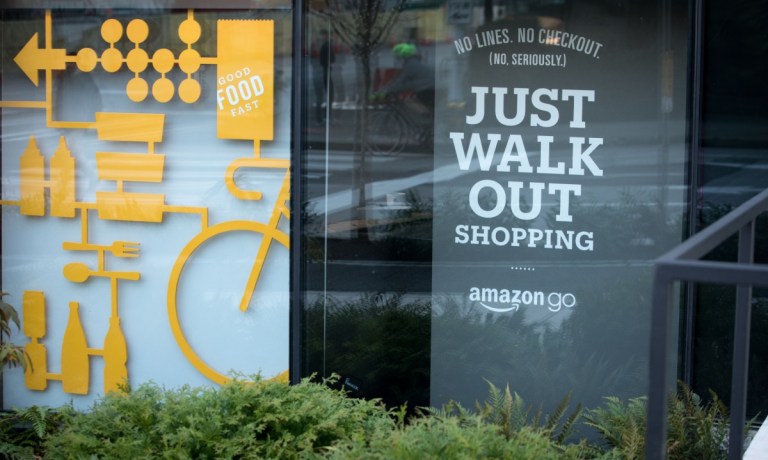As we approach the middle of the year, here are five of the major ways that the retail landscape has changed in 2024 so far.
Amazon Pivots on ‘Just Walk Out’
Last month, news broke that Amazon is pulling back on Just Walk Out technology in its own grocery stores, even as it pushes sales of the checkout system to external merchants.
Dilip Kumar, vice president at AWS Applications, argued that the technology works for smaller stores and that it will be a viable system for full-format supermarkets down the line.
“While we’re growing the number of smaller format Just Walk Out stores, the team continues to invent the next generation of this technology to improve the checkout experience for large-format stores,” Kumar said. “We’re building edge compute and the associated algorithms to improve latency and accuracy for faster and more reliable receipts, a new set of algorithms for action recognition, and new sensors so retailers can offer customers even greater selection.”
With this move, Amazon is competing with Instacart to be the eCommerce engine for the brick-and-mortar grocery store. Instacart has been rolling out a range of in-store technologies to grocers to digitize the experience, including smart carts and own-device scan-and-pay, among others.
Instacart Makes a Super App Play, Teaming With Uber Eats
In fact, Instacart is not just trying to own the in-store and online grocery experience. It is also looking to capture consumers’ engagement at more parts of their day. Earlier this month, the company announced a partnership with Uber to enable ordering from Uber Eats restaurants via Instacart’s app.
Advertisement: Scroll to Continue
“Through this partnership, Instacart customers now have access to both the best online grocery selection in the U.S. and restaurant delivery, making it even easier for them to conveniently tackle all their food needs from a single app,” Instacart CEO and Chair Fidji Simo said in a statement.
The move comes as merchants adapt to consumers’ evolving food habits, increasingly viewing eating not in terms of disparate categories but as a single, connected concept.
“In this connected economy, grocery stores and restaurants and aggregators now compete for the consumer’s share of stomach and food spend,” PYMNTS’ Karen Webster wrote. They do that in a category consumers don’t think of as grocery stores or restaurants or delivery aggregators, but eating.”
Walmart Aims to Close the Income Gap With Amazon
Walmart has been stepping up Walmarche strategy, a term coined by Webster describing the retailer’s efforts to attract a higher-income demographic by piloting a new merchandise mix and fancier displays.
“Walmart must first convince high earners that they’ll find recognizable designer brands or really high-quality dupes at cheaper prices than they’d find elsewhere, and then make shopping at Walmart a habit,” Webster noted. “It’s not clear that Carbone pasta sauce and knock-off navy blazers will be enough to change high-earner shopping habits — especially when most of the product mix and shopper profile inside of a Walmart store remains largely the same. And when many high-income shoppers make such purchases online for the convenience of not having to walk inside.”
According to PYMNTS Intelligence, Amazon’s share of high-income consumers is 36% higher than Walmart’s, and while Walmart’s shoppers are roughly evenly distributed across income brackets (less than $50K a year, between $50K and $100K, more than $100K), more than half of Amazon’s shoppers fall into the high-income group. In fact, only 16% of Amazon customers make less than $50K annually.
Kroger Gets Back to Basics
Speaking of retailers possibly biting off more than they can chew, Kroger is turning its focus back to grocery. In March, The Kroger Company announced plans to sell the business to CarelonRx, a subsidiary of Elevance Health, with the sale expected to close in the second half of the year.
“As part of our regular review of assets, it became clear that our strong specialty pharmacy business unit will better meet its full potential outside of our business,” Colleen Lindholz, president of Kroger Health, said in a statement.
Many retailers have made moves into pharmacy. Walmart and Costco, for instance, both have pharmacies, as do some smaller supermarket companies such as Publix and H-E-B. Yet Kroger is not the only company in the space pulling back on the category. Late last summer, for instance, southern supermarket chain Winn-Dixie began shuttering pharmacy locations in the leadup to a planned merger with Aldi, which does not have a pharmacy business.
Kroger’s move may serve as a testament to the model used by Target, which houses CVS locations within its stores. The collaboration enables the retailer to benefit from the pharmaceutical foot traffic without incurring the high cost of running its own healthcare subsidiary.
Losing Share to Amazon, Brick-and-Mortar Retailers Close Up Shop
With consumers increasingly getting their cross-category retail needs met via Amazon — everything from couture to colored pencils — specialty retailers are struggling. For instance, earlier this month, music retailer Sam Ash announced that it is closing all its stores.
Discount retailer Dollar Tree said in March that it plans to close nearly of its 1,000 Family Dollar locations, and less than a month later, 99 Cents Only announced its Chapter 11 filing and said it was closing all of its 371 locations in the southwestern part of the country.
In February, Macy’s announced plans to shutter 150 of its stores as it focuses on its luxury brands.
The month prior, it was reported that Signet Jewelers — owner of Kay Jewelers, Zales and Jared — is closing up to 150 American and British locations by the middle of the year.
All this, as Amazon’s share of consumer retail spending climbs ever upward, hitting 10% by PYMNTS Intelligence’s estimate in Q4 of last year.

